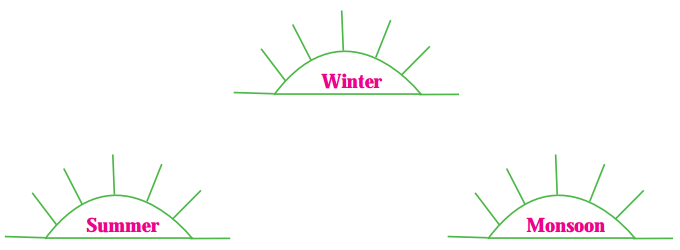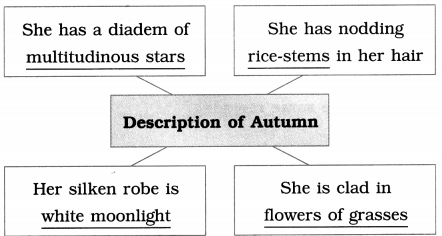Balbharti Maharashtra State Board Class 9 English Solutions Kumarbharati Chapter 2.5 Autumn Notes, Textbook Exercise Important Questions and Answers.
English Kumarbharati 9th Solutions Chapter 2.5 Autumn Textbook Questions and Answers
Warming up:
1. What changes do you see in nature in each of the following seasons? A few sentences are given below as examples. Use these and your own to describe a season appropriately.

Question 1.
What changes do you see in nature in each of the following seasons? Use the sentences given on textbook page 49 and your own to describe each season appropriately.
Answer:
(a) Summer:
(b) Winter:
(c) Monsoon:
Question a.
Name the six seasons according to the Indian calendar. Which of these seasons is equivalent to Autumn?
Answer:
The six seasons according to the Indian calendar are :
Vasant, Grishma, Varsha, Sharad, Hemant and Shishir. Sharad Ritu is equivalent to Autumn.

Question b.
What changes do we see in the life of human beings when the season changes? Write with reference to their (a) clothes (b) diet
(c) celebrations.
Answer:
(a) clothes :
Points :
(b) diet :
Points :
(c) celebrations :
Points :

2. Guess what is personified and fill in the gaps. Choose from the brackets.
(Sun, alarm, bird, car, wind, stars, machine)
Question 1.
Guess what is personified and fill in the gaps with words from the brackets :
(sun, alarm, bird, car, wind, stars, machine) (The answers are given directly.)
(a) The weary ……… was also petrol – hungry.
(b) The playful …….. whistled among the trees.
(c) The annoying ……. screamed at 5 am.
(d) The naughty …….. winked at me from above.
(e) The rising ……. stretched its arms.
(f) The cheerful …… sang as it perched on a tree.
(g) The tireless …….. hummed as it worked hard.
Answer:
(a) The weary car was also petrol-hungry.
(b) The playful wind whistled among the trees.
(c) The annoying alarm screamed at 5 a.m.
(d) The naughty stars winked at me from above.
(e) The rising sun stretched its arms.
(f) The cheerful bird sang as it perched on a tree.
(g) The tireless machine hummed as it worked hard.

English Workshop:
1. Find three lines each, that contain images of nature in the autumn season. ..
Question 1.
Find three lines each, that contain images of nature in the autumn season :
(a) During daytime
1. ……………………..
2. ……………………..
3. ……………………..
(b) At night
1. ……………………..
2. ……………………..
3. ……………………..
Answer:
(a) During daytime :
(b) At night :

2. Pick out words from the poem that describe the following. List them in Column ‘A’. Substitute each of those describing words with another word/phrase of the same meaning.

Question 1.
Pick out words from the poem that describe the following. List them in Column A. Substitute each of those describing words with another word/ phrase of the same meaning.
Answer:
| A (Poetic words) | B (Your own words) | |
| 1. The Autumn | A maiden fair | A beautiful maiden |
| 2. Stars | Multitudinous | Numerous, Countless |
| 3. Moonlight | White | Silvery |
| 4. Cooing of birds | A bracelet’s tinkling | A musical sound |

3. Find one example of each of the following from the poem :
Simile
Metaphor
Question 1.
Simile
Answer:
Simile – Birds greet her with their cooing glad, Like a bracelet’s tinkling sound.
Question 2.
Metaphor
Answer:
Metaphor – The Autumn comes, a fair maiden.
4. Write the rhyme scheme of the poem.
Question 1.
Write the rhyme scheme of the poem.
Answer:
The rhyme scheme is ababcdcd.
5. Think and write in your own words.
Question a.
Why is the maiden Autumn said to wear rice stems in her hair?
Answer:
Probably the harvest of the rice crop is just over at the beginning of Autumn; hence the maiden Autumn is said to wear rice stems in her hair.

Question b.
How can the tender maiden Autumn become a full grown woman? What change in nature does it imply?
Answer:
When the Autumn season is just beginning, Autumn is a tender maiden, young and graceful. As the season progresses and sets in properly, she becomes a full grown, mature woman. It implies that time has passed and the season has changed.
Question c.
Why do you think that birds greet the autumn season gladly?
Answer:
Probably the birds enjoy the cool autumn after the hot summer. They may also get more grains and seeds to eat.
6. Compare the Indian Monsoon season to a powerful king of a prosperous kingdom. Write down a few similarities. Use them to compose a poem of your own.
Question 1.
Compare the Indian Monsoon season to a powerful king of a prosperous kingdom. Write down a few similarities. Use them to compose a poem of your own.
Answer:
(Students may attempt this on their own.)

7. Which is your favourite ‘Nature’ poem from your mother tongue? Write the poem and try to translate it into English. Your translation can be in the form of a poem or a paraphrase.
Question 1.
Which is your favourite ‘Nature’ poem from your mother tongue? Write the poem and try to translate it into English. Your translation can be in the form of a poem or a paraphrase.
Answer:
(Students may attempt this on their own.)

8. Read the ode ‘To Autumn’ by the famous poet John Keats. ‘Season of mists and mellow fruitfulness…’
Question 1.
Read the ode ‘To Autumn’ by the famous poet John Keats. ‘Season of mists and mellow fruitfulness…’
English Kumarbharati 9th Digest Chapter 2.5 Autumn Additional Important Questions and Answers
Read the following poem carefully and complete the activities:
Simple Factual Activity:
1. Complete the web:
(The answers are underlined directly.)

Complex Factual Activities:
Question 1.
What is the cooing of birds compared to?
Answer:
The cooing of birds is compared to the tinkling song of a bracelet.

Question 2.
How does Autumn dress up at night?
Answer:
At night Autumn wears a twinkling crown made of countless stars. Her robe of silk is the white moonlight, set free from the cloudy patches.
Question 3.
Why is Autumn called a ‘maiden fair’?
Answer:
Autumn is said to be slender and graceful. She has adorned herself by having rice-stems in her hair and lilies in her face. She is dressed in flowers of grasses. Hence, she is called a ‘maiden fair’.

Paragraph Format:
In the poem ‘Autumn’, the poet Kalidas has lovingly and picturesquely described the advent of the Autumn season. The original poem in Sanskrit is translated into English by Prof. A. W. Ryder.
The Rhyme Scheme is ababcdcd. A Figure of Speech that stands out is Alliteration: ‘She seems a slender maid, who soon…’. Repetition of the sound of the letter ‘s’. Other figures of speech are Simile and Metaphor.
The poet has compared Autumn to a slender and graceful maiden who has adorned herself in various ways.
The poem is enchanting because of the imagery and the beautiful, imaginative description of Autumn. It shows us the imagination of the poet. Autumn is personified in the entire poem and compared to a slender and graceful maiden.
Maharashtra State Board Class 9 English Solutions
You must be logged in to post a comment.